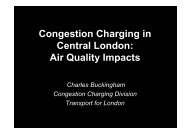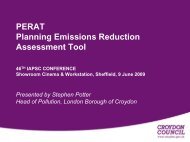Cars and behaviour: psychological barriers to car restraint ... - iapsc
Cars and behaviour: psychological barriers to car restraint ... - iapsc
Cars and behaviour: psychological barriers to car restraint ... - iapsc
Create successful ePaper yourself
Turn your PDF publications into a flip-book with our unique Google optimized e-Paper software.
good c<strong>and</strong>idate for measurement. In<br />
moni<strong>to</strong>ring indica<strong>to</strong>rs, the effects of<br />
each intervention are analysed, as well<br />
as the combined effects of any<br />
interactions between them. One<br />
general indica<strong>to</strong>r that is used <strong>to</strong><br />
determine the effectiveness of the<br />
programme in relation <strong>to</strong> the<br />
investments made is the costeffectiveness<br />
of the programme.<br />
Indica<strong>to</strong>rs of the ECO-DRIVING programme<br />
For ECO-DRIVING two effect indica<strong>to</strong>rs are defined <strong>to</strong><br />
moni<strong>to</strong>r the overall result of the programme:<br />
Avoided CO2 emissions (in <strong>to</strong>ns per year)<br />
represents the annual amount of CO2 that is not<br />
emitted as a result of the programme activities;<br />
3<br />
Cost-effectiveness<br />
relates the <strong>to</strong>tal costs<br />
(subsidies <strong>and</strong> labour) of the programme <strong>to</strong> the<br />
amount of avoided CO2 emissions.<br />
Phase 4: Development of computation methods<br />
In the fourth phase the computational method is developed. It depicts how <strong>to</strong> quantify the<br />
indica<strong>to</strong>rs of phase three. Computational methods can be aggregate or disaggregate. In the first<br />
approach one measures the overall effect of the programme thereby controlling for the<br />
influence of external fac<strong>to</strong>rs. In the second approach the effects of all programme activities are<br />
quantified separately <strong>and</strong> added in<strong>to</strong> a composite or overall measure of change.<br />
The way avoided CO2 emissions are computed is illustrated by a project concerning the training of<br />
driving school instruc<strong>to</strong>rs <strong>and</strong> examiners in 2002 <strong>and</strong> 2003. The main objective of this project was <strong>to</strong><br />
incorporate ECO-DRIVING in driving lessons <strong>and</strong> exams for novice drivers.<br />
investments: € 2,000,000 (in 2 years)<br />
participation rate: 175,000 x 93% x 92%<br />
effectiveness: 35%<br />
CO2 emissions per driver: 1.6 <strong>to</strong>n/year<br />
efficiency rate of driver training: 10%<br />
Figure 3: Application of the evaluation <strong>and</strong> moni<strong>to</strong>ring method<br />
avoided CO2 emissions: 8,385<br />
<strong>to</strong>n<br />
cost-effectiveness: 7.6 € per <strong>to</strong>n<br />
A significant majority of the driving instruc<strong>to</strong>rs <strong>and</strong> examiners was trained (6,500 out of 7,000 in <strong>to</strong>tal<br />
is 93%). Many trained driving instruc<strong>to</strong>rs will teach novice drivers the main ECO-DRIVING principles<br />
as well. According <strong>to</strong> an inquiry 92% of the trained driving instruc<strong>to</strong>rs stated that they would<br />
incorporate ECO-DRIVING within their driving lessons. Annually about 175,000 novice drivers pass<br />
the driver’s license exam. The investment amounted <strong>to</strong> € 2,000,000 in two years. The percentage of<br />
novice drivers that will apply the ECO-DRIVING style was assumed <strong>to</strong> be 35%. The average amount<br />
of CO2 emissions from a typical novice Dutch driver equals 1.6 Ton per year. Based on the results of<br />
several field experiments, it is assumed that CO2 emissions will reduce by 10% if <strong>car</strong> drivers apply an<br />
ECO-DRIVING style instead of applying a usual driving style. Therefore the efficiency rate equals<br />
10%. By means of these figures the avoided CO2 emissions <strong>and</strong> the cost-effectiveness could be<br />
computed (see both the figures 3 <strong>and</strong> 4).<br />
The cost-effectiveness is a relevant indica<strong>to</strong>r that relates the investment <strong>to</strong> the effects. Because<br />
government programmes that aim <strong>to</strong> change consumers’ <strong>behaviour</strong> are typically investments<br />
for the long-term, these programmes also influence the <strong>behaviour</strong> in the years ahead. For ECO-<br />
DRIVING this is shown in figure 4. To relate investments <strong>to</strong> avoided CO2 emissions, an<br />
annuity computation is applied. In using this method investments are spread out over several<br />
years <strong>and</strong> compared <strong>to</strong> a mean amount of avoided CO2 emissions in the same time period.










